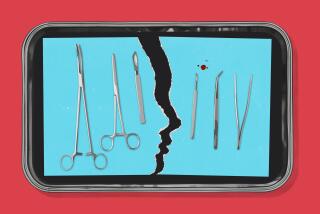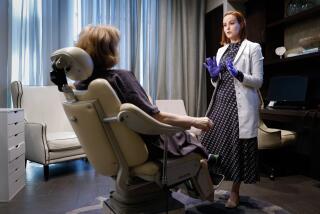Computer Shows Patients How Looks Can Be Altered : Surgeons Use Frozen Video Frames to Sketch Post-Operative Views of Faces, Eliminate Mysteries
- Share via
When 56-year-old Elaine Star looked at the face on the TV monitor, she felt amazed. “It was a miracle. I said, ‘My God, that’s the way I used to look!’ ” Star sat face-to-face with a much younger version of herself, the image of a woman she’d nearly forgotten.
But the frozen video frame hadn’t come from an old picture album. The shot was taken moments earlier, then altered by Dr. Barry Weintraub to reveal the changes he could make--if she wanted them--with plastic surgery.
Fewer Disappointments
Star, a Los Angeles accessories designer, is one of the few surgery patients to benefit so far from a futuristic marriage of personal computer and video technology. Advocates say it will make the time-honored “Take a little off here, tighten the skin there” just a first step in a more precise process that allows patients to see exactly what can (and can’t) be done by their surgeon. If used carefully, says Weintraub, the technique clears away any fog of misunderstanding between patient and doctor before surgery, leading to fewer disappointments when the bandages come off.
“There are no mysteries left,” says Star, who went ahead with the facial surgery after years of indecision.
Only a handful of American plastic surgeons are currently using the new method, according to Dr. Henry Kawamoto Jr. of the American Society of Plastic and Reconstructive Surgeons’ Patient Education Committee. But this technique may be used far more widely in the future, he says. “It’s quite helpful in terms of conveying the possibilities available to a patient. They always want to know what they’re going to look like.”
Using a small camera set on a tripod, Weintraub takes a frozen-frame video of the patient in his Beverly Hills office. The video frame is displayed on a TV monitor.
At the base of the screen is a magnetic drawing board with an electric pen attached. Beside the monitor sits a personal computer, whose software is programmed to allow the pen on the drawing board to interact with the video frame on the screen.
‘Redraw’ a Person
That means the doctor, sketching on the board, can flatten nose bumps, blend out wrinkles and under-eye bags or tighten flapping skin--in effect “redraw” a person appearing on the screen. The doctor also can modify, or even remove, proposed changes. The monitor will produce printouts showing different results.
“The patient may say, ‘I’d like a little more off there’ or ‘I’d like less done here.’ ‘No, I want the tip of the nose pointing more toward the floor.’ I can do it, and they can see how it will look,” says Weintraub, a board-certified plastic and reconstructive surgeon on staff at Cedars-Sinai Medical Center.
While some patients, like Star, are thrilled at their video redo, others find expectations don’t match what a plastic surgeon can deliver, and that’s worth knowing, too. “We’ve been able to screen out some people with unrealistic expectations. It’s useful in terms of not creating false hopes. In fact, I think of it as a more informed consent,” says Dr. Ian Brown, a Beverly Hills surgeon who’s been using the technique for about a month.
He reserves the left side of the screen for a freeze frame of the patient as is, the right side for altered views, so the two can be compared readily. “We even compute what size chin or cheekbone implant the patient will need from the video,” says Brown, a board-certified facial plastic surgeon affiliated with White Memorial Medical Center in Los Angeles.
Weintraub has been experimenting with the technology for a year, using it on about 50 patients. He claims he has never had patients complain that they didn’t turn out as well as their printouts. Weintraub says he is in the process of preparing research material on 30 of the patients and hopes to publish soon in a professional journal.
“I strongly advocate that conservatism be the rule in using this. Even if you know you can do a better nose than what you’re showing, that’s preferable to showing something you can’t accomplish.” But as for the technology, “It’s all purchasable,” he notes. And anyone, including less scrupulous surgeons, could use the fancy technique to oversell operations, promising beautiful images they cannot duplicate.
“It could be a Pandora’s box we’ve opened,” Weintraub admits, because the technology is only constructive in the hands of honest doctors.
Even if the surgeon doesn’t intend to mislead, the method won’t provide a foolproof preview of how patients will turn out, cautions Kawamoto of the American Society of Plastic and Reconstructive Surgeons. Occasionally, in the healing process, scars or bone structure may pull one way or the other, leading to a slightly different result than expected. “We’re talking about fractions of inches, but there may be slight deviations from what you see on the screen,” says Kawamoto.
The new video/computer technology--which can heighten surgery’s appeal--makes it all the more important that patients carefully check out the academic and speciality certification credentials of their surgeons, he suggests.
“No bona fide plastic surgeon is ever insulted if you thoroughly check him out,” says Kawamoto, a staff member at UCLA and St. John’s hospitals.
In the future, the technology in this field will continue to leap ahead and be applied in new ways for people considering plastic surgery, says Weintraub. On the horizon:
--Within six months, three-dimensional displays of patient outcomes will be available, he predicts, noting that development of this software already is well under way.
--Although Weintraub has tried video previews mostly for cosmetic surgery cases so far, he has just begun to use the technique with parents whose children have physical deformities. “They’re often frightened and uncertain because they don’t know how the child will look after surgery. Now we’re able to show them.”
--Within a few years, he predicts the technology will be used to link surgeons outside major cities, who are stumped by cases demanding special expertise, with specialists who can convey both video frames and detailed surgical instructions to colleagues via their computer/video terminals. “It’s going to revolutionize how we do plastic surgery,” Weintraub says.






